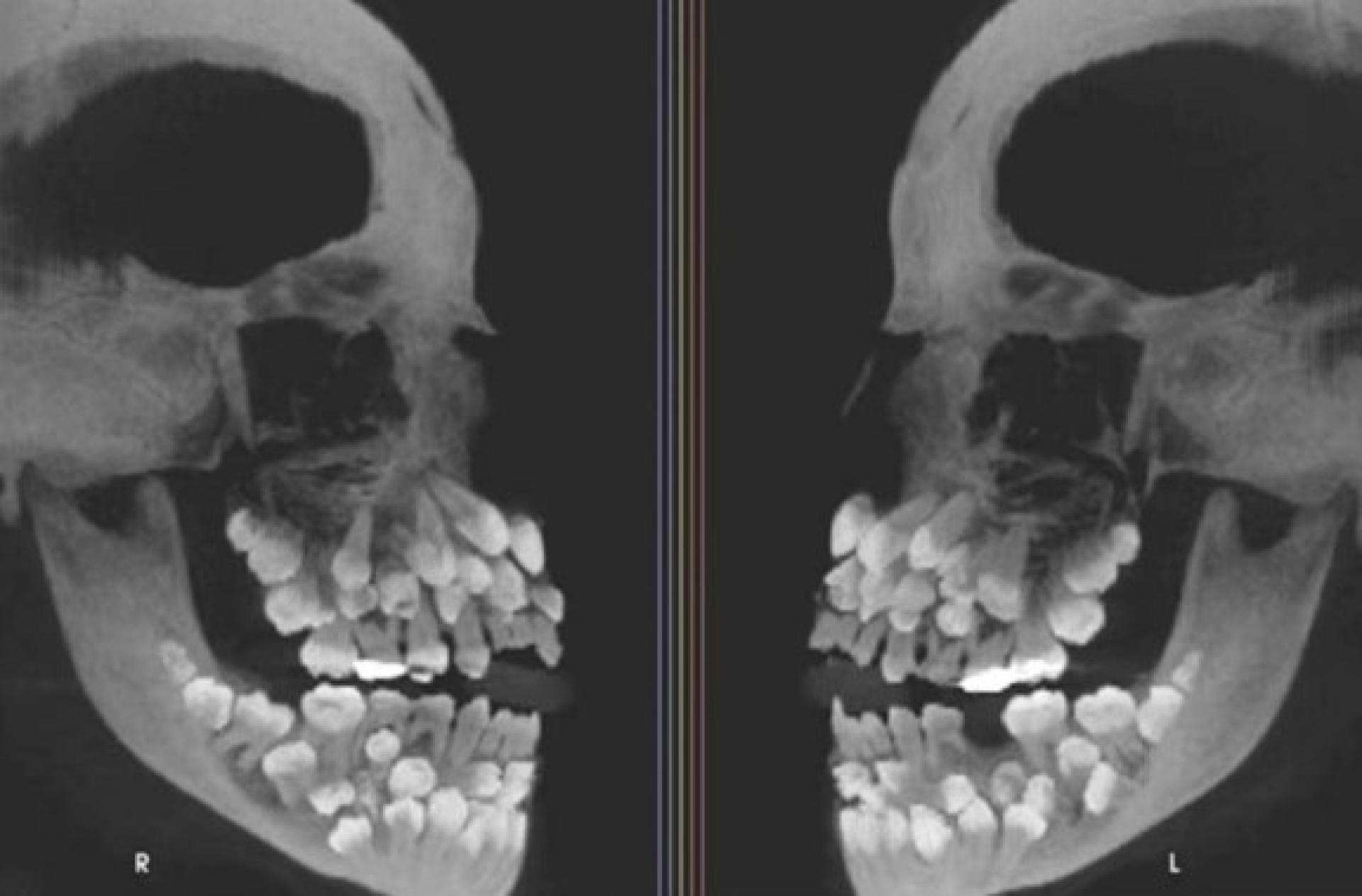(Brazil, 20th) An 11-year-old girl in Brazil was discovered to have 81 teeth in her mouth, including 18 baby teeth, 32 permanent teeth, and 31 supernumerary teeth, far exceeding the normal 32 permanent teeth in adults. This case was published in the American Journal of Orthodontics and Dentofacial Orthopedics and has attracted attention from the academic world globally.
The 11-year-old girl visited the dental hospital at the Federal University of Juiz de Fora to have an upper baby tooth removed. At that time, no obvious abnormality was found through clinical examination, but the results of the X-ray examination were astonishing: it revealed a total of 81 teeth in her mouth. The girl was subsequently diagnosed with hyperdontia. The research team further used cone-beam computed tomography (CBCT) to confirm the precise location and morphology of the teeth and found that the supernumerary teeth were distributed throughout the dental arch, some deeply embedded in the gums and with abnormal shapes, making them difficult to distinguish from normal teeth.
Hyperdontia is a rare dental developmental anomaly that usually involves only 1 or 2 supernumerary teeth; cases of more than 30 teeth are extremely rare, with only a few reported worldwide. The 31 supernumerary teeth in this case are astonishing in number, and the patient shows no typical associated syndromes such as cleidocranial dysplasia, Gardner’s syndrome, or cleft lip and palate, making it nonsyndromic hyperdontia, which adds complexity to both diagnosis and treatment.
The research team referred the girl to a genetics specialist for examination. G-banding chromosomal analysis showed a peripheral inversion of chromosome 9, which is a rare genetic variation. However, the researchers noted that currently there is no conclusive evidence that this inversion directly causes hyperdontia, as the causes of supernumerary teeth are still not fully understood and may involve a complex interplay of excessive dental lamina activity, genetic, or environmental factors.
The research team pointed out that supernumerary teeth can lead to dental crowding, obstruction of permanent tooth eruption, malocclusion, or cyst formation. If not properly extracted, they may damage the jawbone or adjacent teeth, so treatment must be approached cautiously. This girl's case, due to the high number, abnormal shapes, and complex distribution of the supernumerary teeth, poses a significant clinical challenge. Accordingly, the research team set up a multidisciplinary team including orthodontics, oral and maxillofacial surgery, periodontics, and prosthodontics to map out a long-term treatment plan. The girl's treatment is expected to take several years, requiring multiple surgeries and orthodontic corrections.
In the report, the research team stated: “The phenomenon of dozens of supernumerary teeth demonstrates the diversity of human development.” They urge regular dental check-ups for early detection of abnormalities.
The 11-year-old girl visited the dental hospital at the Federal University of Juiz de Fora to have an upper baby tooth removed. At that time, no obvious abnormality was found through clinical examination, but the results of the X-ray examination were astonishing: it revealed a total of 81 teeth in her mouth. The girl was subsequently diagnosed with hyperdontia. The research team further used cone-beam computed tomography (CBCT) to confirm the precise location and morphology of the teeth and found that the supernumerary teeth were distributed throughout the dental arch, some deeply embedded in the gums and with abnormal shapes, making them difficult to distinguish from normal teeth.
Hyperdontia is a rare dental developmental anomaly that usually involves only 1 or 2 supernumerary teeth; cases of more than 30 teeth are extremely rare, with only a few reported worldwide. The 31 supernumerary teeth in this case are astonishing in number, and the patient shows no typical associated syndromes such as cleidocranial dysplasia, Gardner’s syndrome, or cleft lip and palate, making it nonsyndromic hyperdontia, which adds complexity to both diagnosis and treatment.
The research team referred the girl to a genetics specialist for examination. G-banding chromosomal analysis showed a peripheral inversion of chromosome 9, which is a rare genetic variation. However, the researchers noted that currently there is no conclusive evidence that this inversion directly causes hyperdontia, as the causes of supernumerary teeth are still not fully understood and may involve a complex interplay of excessive dental lamina activity, genetic, or environmental factors.
The research team pointed out that supernumerary teeth can lead to dental crowding, obstruction of permanent tooth eruption, malocclusion, or cyst formation. If not properly extracted, they may damage the jawbone or adjacent teeth, so treatment must be approached cautiously. This girl's case, due to the high number, abnormal shapes, and complex distribution of the supernumerary teeth, poses a significant clinical challenge. Accordingly, the research team set up a multidisciplinary team including orthodontics, oral and maxillofacial surgery, periodontics, and prosthodontics to map out a long-term treatment plan. The girl's treatment is expected to take several years, requiring multiple surgeries and orthodontic corrections.
In the report, the research team stated: “The phenomenon of dozens of supernumerary teeth demonstrates the diversity of human development.” They urge regular dental check-ups for early detection of abnormalities.
